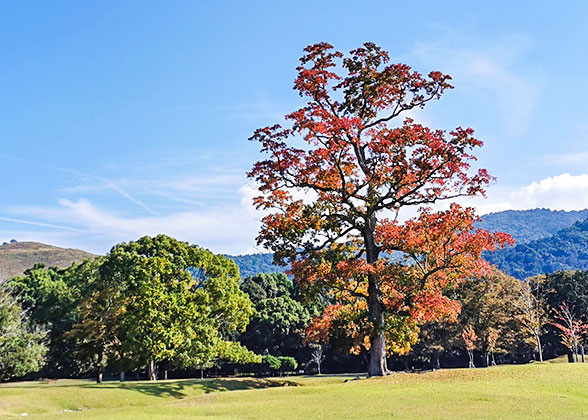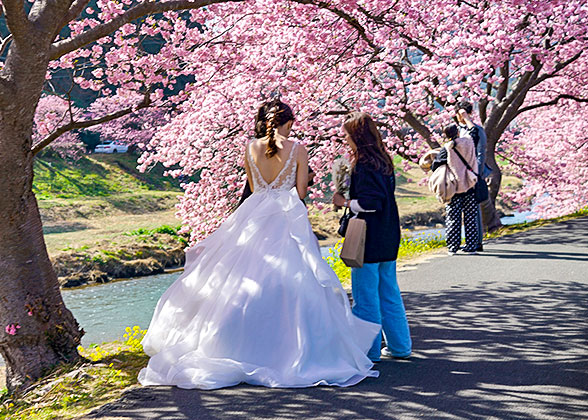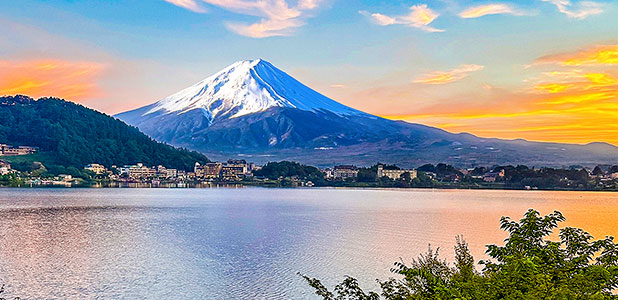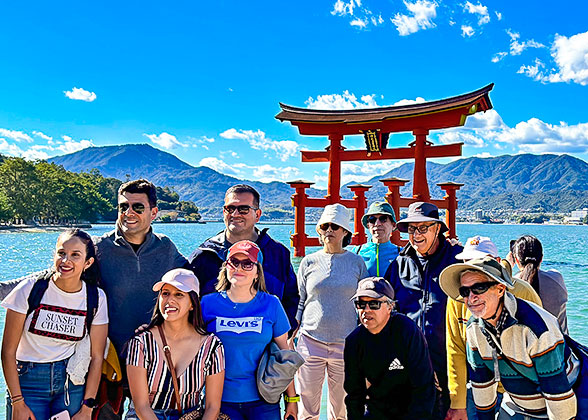Japan Weather
Overall, Japan experiences distinct four seasons with pronounced maritime climate characteristics: Spring is mild; summer brings humid and muggy conditions across most regions, though areas like Hokkaido offer warm and comfortable weather; autumn is pleasantly cool; and winter has climate varying considerably by regions: cities on the Sea of Japan coast experiences quite high snowfall and cold climate, while those on the Pacific side tends to be much sunnier with a little higher temperature. Additionally, Japan has a rainy season that lasts for several weeks each year from May to July, and the typhoon season peaks from August to October, often bringing strong winds and heavy rain.

Beautiful Cherry Blossoms in Japan
|
Temperature
Japan spans approximately 25 degrees of latitude from north to south, placing it across three climatic zones: subarctic, temperate, and subtropical. This results in significant regional temperature variations.Specifically, in Hokkaido, located in the subarctic zone, the temperature is relatively low: Winters are quite cold, with the temperature typically ranging from -10 to -5 degrees Celsius (14-23 degrees Fahrenheit). Summers, however, are pleasantly cool, with the maximum temperature usually around 25°C (77°F). Southward, in temperate regions like Tokyo, Kyoto, and Osaka, winter temperature is slightly milder, with daily highs and lows at 5-10°C (41-50°F) and -5-0°C (23-32°F), respectively. Summers are also notably warmer, with daily highs reaching 30-35°C (86-95°F). Then, in subtropical regions at the southernmost tip of Japan, like Okinawa, the temperature can reach around 15 to 20°C (59-68°F) even in winter.
(1) Which is the coldest month in Japan?
January is Japan’s coldest month. During this time, the temperature in the northern region, like Hokkaido, can drop to around -15 to -10°C (5-14°F), and you will feel significantly cold. Cities in central areas like Osaka, Kyoto, and Tokyo see lows of approximately -5-0°C (23-32°F), a bit cold level. However, conditions in southern areas like Okinawa are markedly different: even during this coldest month, the minimum temperature remains around 15°C (59°F), cool but not cold at all.

Cold Tokyo in January
|
(2) Which is the hottest month in Japan?
Generally speaking, August is the hottest month in Japan. Except the northern Hokkaido maintains a comfortable daytime temperature of around 25°C (77°F) during this period, most other regions see daytime highs rise above 30°C (85°F). In some areas, you may even experience a high of over 35°C (95°F).Precipitation
Japan lies within the monsoon belt and is surrounded by oceans on all sides, making it a country with abundant precipitation. The national average rainfall reaches 1,700–1,800 mm, nearly double the global average and three times that of temperate cities like London, Paris, and Beijing. Furthermore, precipitation distribution is highly uneven both temporally and spatially.(1) When is the rainiest time in Japan?
The rainy season will last for one month or one and a half months in Japan, generally from May to July. The rainy season begins in the southern islands of Japan in early May or mid-May; the farther north you go, the later the rainy season comes. To the northeast of Honshu, the rainy season comes in early or mid-June. As for Hokkaido, it is relatively an exception in Japan with no rainy season. During the rainy season, there will be extremely frequent rains, though some of which are showers. The high rainfall during this period, on the other hand, also leads to high humidity.

Meiji Jingu Shrine in the Rain
|
Japan sees its typhoon season from June to October generally, with August to early October being the peak months. The entire Japan would encounter 20-30 typhoons every year, and areas including Okinawa, Kyushu, and Shikoku are most frequently affected. Typhoons will bring plenty of rain and gales to the landing areas, which may not only cause inconvenience and uncertainty for your trip but also make it unsafe for outdoor visiting sometimes. So, if you go to Japan during the typhoon season, you have to pay close attention to the local weather forecast.
(2) What is the snowfall situation like in Japan?
The regions along the Sea of Japan coast receive abundant snowfall, including Hokkaido, Aomori, Kanazawa, etc. In these areas, snow not only falls frequently but can also be quite heavy. Mountainous areas such as Nagano also experience significant snowfall. The above-mentioned places are all excellent destinations for enjoying snowy landscapes. In contrast, cities along the Pacific coast, such as Tokyo and Nagoya, receive less snow. As for regions with low latitudes, such as Okinawa, snowfall is virtually nonexistent.

Snowy Hokkaido in Winter
|
See Weather for More Destinations in Japan:
- Fukuoka
- Hakata
- Hakodate
- Hakone
- Hirosaki
- Hiroshima
- Hokkaido
-
Kamakura
- Kanazawa
-
Kobe
- Kyoto
- Lake Kawaguchi
- Mount Fuji
- Nagano
-
Nagasaki
- Nagoya
- Nara
- Nikko
- Okinawa
- Osaka
- Sapporo
- Sendai
- Shirakawa-go
- Shizuoka
-
Takayama
- Tokyo
- Wakayama
- Yokohama
Best Time to Visit Japan
For most areas in Japan, the best visiting times are from March to April and October to November. March through April brings cool or warm temperature and relatively low precipitation across most regions, making it favorable for outdoor exploration. These two months coincide with the Cherry Blossom Season in Japan, when the country is full of pink blossoms. In addition to the similarly pleasant weather, October through November also offers the seasonal landscape of autumn foliage.
|
|
|
If you have decided to visit Japan in 2026, then you may like our Japan Tours 2026 & 2027 with Private & Group Packages.
Spring from March to May: Turning Warm Gradually; Moderate Rainfall
Weather: In spring, the temperature across Japan rises. Most cities experience very pleasant weather: southern regions like Okinawa get warm temperatures of 15-20°C (59-68°F) starting in March, which climb to around 20-25°C (68-77°F) by May. Cities in central Japan, such as Tokyo, Kyoto, Kanazawa, and Hiroshima, gradually see temperatures rise from approximately 5-10°C (41-50°F) to around 15-20°C (59-68°F). As for Hokkaido, although temperatures remain relatively low at -5-0°C (23-32°F) in March, they increase quickly, reaching around 10-20°C (50-68°F) by May. During this period, rainfall increases month by month in some cities, and cities like Okinawa even enter the rainy season in late spring. But overall, the precipitation stays moderate. While you should definitely bring an umbrella and check the weather forecast, you needn’t worry that rain will significantly disrupt your travels.

Warm and Sunny Spring in Japan
|
![]() What to Bring:
What to Bring:
Others: umbrellas
Summer from June to August: Muggy Most Cities but Warm Overall Hokkaido
Weather: During the summer months of June and July, most of Japan’s cities experience the rainy season, when the country’s average number of rainy days is over 10 per month. Intermittent yet frequent rainfall can make sightseeing inconvenient and may somewhat affect visibility. By August, Japan enters its peak typhoon season, with the potential for severe weather like strong winds and heavy rain. Temperature-wise, most cities see daily lows and highs ranging from 20-25°C (68-77°F) and 30-35°C (86-95°F), respectively, in summer. The combination of high temperatures and high humidity caused by high precipitation makes you feel sticky and uncomfortable. Hokkaido, however, stands as an exception: First, it has no rainy season and is relatively less affected by typhoons. Second, daily temperatures here generally hover around 20-30°C (68-86°F). So, its climate is much cozier.
|
|
|
Clothes & Shoes: thin and breathable T-shirts, shorts, dresses, sun-protective jackets; lightweight and breathable sneakers and water shoes
Others: umbrellas; mosquito repellent spray; sun-protection items like sunscreen, sunhats, and sunglasses
Autumn from September to November: Turning Cool Temperature; Moderate Rainfall
Weather: Overall, Japan weather in autumn is not bad. Temperatures in the southern and central regions drop from 25-30°C (77-86°F) to around 20-25°C (68-77°F) and 10-20°C (50-68°F), respectively, offering ideal conditions for outdoor activities like hiking. In Hokkaido, temperatures decrease from comfortable 20-25°C (68-77°F) to around 5-10°C (41-50°F) by late autumn, and you might find it a bit chilly. In terms of precipitation, rainfall remains relatively frequent from September through early October, as Japan is still affected by typhoons during this period. After that, precipitation decreases significantly in most cities, and the weather becomes much sunnier. However, note that rainfall may increase in cities along the Sea of Japan coast, such as Kanazawa. In terms of scenery, it’s worth mentioning that October to November marks the peak season for autumn foliage.

Beautiful Autumn Foliage
|
![]() What to Bring:
What to Bring:
Others: umbrellas, especially if your trip is scheduled in early autumn
Winter from December to February: Cold Most Places; Snowy Cities along Sea of Japan
Weather: Winter climate of Japan is quite complex. Southern regions like Okinawa experience relatively low rainfall and remain warm with temperatures of around 15-20°C (59-68°F). Moving northward, temperatures gradually decrease. In most cities of central Japan, daily highs and lows hover around 0-10°C (32-50°F) and -5-0°C (23-32°F) respectively, and you won’t feel very cold. Most cities in this region experience both rain and snow in winter, though neither is frequent: winter marks the lowest precipitation period of the year for them. However, cities along the Sea of Japan coast typically experience quite frequent snowfall, forming Japan’s “Snow Country”. Take Kanazawa as an example: each winter month sees an average of over 20 days with snow. Then, in Hokkaido, the northernmost part of Japan, temperatures drop to around -5-5°C (23-41°F) at the beginning of the season, and fall to around -10 to -5°C (14-23°F) during the coldest periods. Also belongs to “Snow Country”, it is a prime destination in Japan for snow appreciation in winter.
|
|
|
![]() What to Bring:
What to Bring:
Clothes & Shoes: long-sleeved T-shirts, hoodies, thin windbreakers,
and light pants for southern regions; sweaters, down coats, padded
trousers, and thick and non-slip shoes for other places
Others: scarves and hats for regions like Hokkaido
![]() Travel
Tips: Visiting Japan’s cities along the Sea of Japan coast to admire
the attractive snow scenery, enjoy snow activities, and attend snow
festivals is highly recommended during winter. However, be aware that
heavy snow can sometimes severely disrupt flights and local
transportation. Be sure to check weather forecasts and transportation
updates multiple times before departure. Additionally, since these areas
are popular travel destinations during this season, especially
Hokkaido, you need to book flights and hotels well in advance. If you
are looking to escape the cold and crowds, destinations like Okinawa are
excellent alternatives.
Travel
Tips: Visiting Japan’s cities along the Sea of Japan coast to admire
the attractive snow scenery, enjoy snow activities, and attend snow
festivals is highly recommended during winter. However, be aware that
heavy snow can sometimes severely disrupt flights and local
transportation. Be sure to check weather forecasts and transportation
updates multiple times before departure. Additionally, since these areas
are popular travel destinations during this season, especially
Hokkaido, you need to book flights and hotels well in advance. If you
are looking to escape the cold and crowds, destinations like Okinawa are
excellent alternatives.
You May Like
-
 10 Days Private Tour of Tokyo - Mt. Fuji - Nagoya - Takayama - Shirakawa-go - Kanazawa - Kyoto - Nara - Hiroshima - Osaka from USD3756
10 Days Private Tour of Tokyo - Mt. Fuji - Nagoya - Takayama - Shirakawa-go - Kanazawa - Kyoto - Nara - Hiroshima - Osaka from USD3756 -
 7 Days Mini Group Tour with Essence of Japan: Tokyo - Mt. Fuji - Kyoto - Nara - Osaka from USD2155
7 Days Mini Group Tour with Essence of Japan: Tokyo - Mt. Fuji - Kyoto - Nara - Osaka from USD2155 -
 8 Days Mini Group Tour to Tokyo - Hakone & Mt. Fuji - Kyoto - Nara - Osaka - Hiroshima - Osaka from USD2771
8 Days Mini Group Tour to Tokyo - Hakone & Mt. Fuji - Kyoto - Nara - Osaka - Hiroshima - Osaka from USD2771


